Best Blacksmith Hammers for Forging
Abana Chapter
February 23, 2024
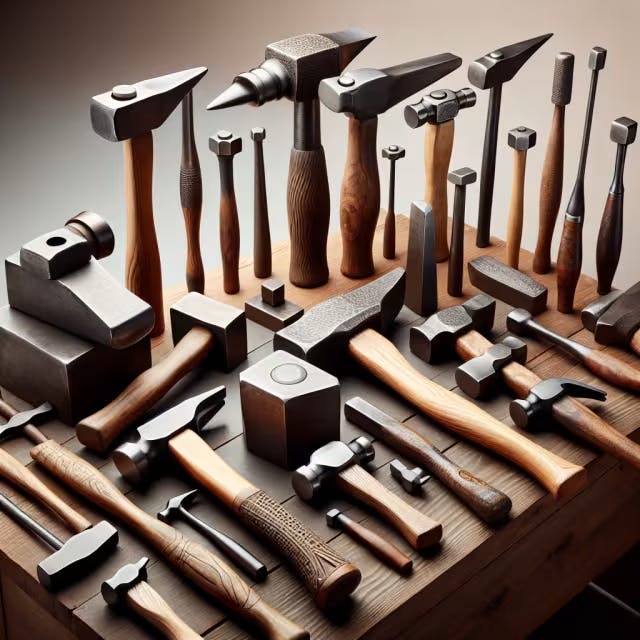
The art of blacksmithing has long stood as a testament to skillful craftsmanship, where the clink of metal and the roar of the forge combine to shape the world one hammer strike at a time. For the modern artisan or the hobbyist with a passion for traditional metalworking, selecting the best blacksmith hammers for forging is crucial to mastering this age-old craft. Understanding the intricacies of hammer selection is essential, whether it's assessing the ideal weight for your striking tool or identifying the supreme materials that promise both resilience and balance for countless hours at the anvil.
Key Takeaways
Selecting the appropriate blacksmith hammer is vital for efficiency and craftsmanship in metalworking.
The ideal hammer weight is important and varies depending on the user and the task at hand.
High-quality materials are crucial for hammer durability and maintaining balance during forging.
The type of handle on a hammer affects the overall blacksmithing efficiency and comfort.
Regular maintenance of your blacksmith hammer can extend its lifespan and performance.
Investigating the top features of forging hammers, such as head design and weight distribution, will lead to better tool selection for specific forging tasks.
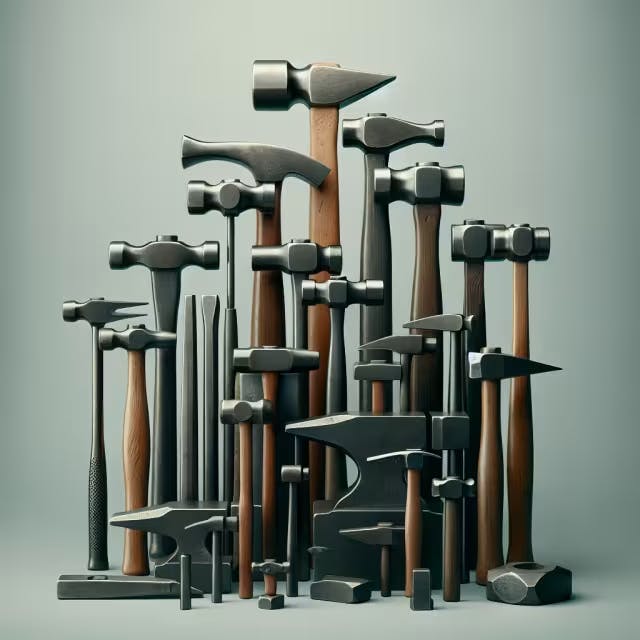
Choosing the Right Blacksmith Hammer for Your Forging Needs
Crafting with metal requires precision and the right tools; choosing the best blacksmith hammer for forging is crucial for any blacksmith. The Picard Hammer - Blacksmiths' Hammer 0000811-1000 is highly regarded for its balance and quality. Made in Germany, this hammer is well-suited for professionals and amateurs alike, offering excellent control and durability.
Hammer Type | Head Weight | Handle Material | Ideal For |
Picard Hammer | 1000g | Hickory | All-purpose forging |
Estwing Sure Strike | 40oz | Fiberglass | Power and comfort with less fatigue |
Vaughan 591-10 SH | 1.5lbs | Hickory | Detail work and smaller projects |
The Estwing Sure Strike Blacksmith's Hammer boasts a 40-ounce head and a fiberglass handle that absorbs shock, while also providing a comfortable grip for prolonged use. This makes it a top choice for those who work long hours and require a hammer that minimizes the effects of repetitive motion.
For finer, more detailed work, the Vaughan 591-10 SH Mini Sledge is an excellent option. Weighing just 1.5 pounds, it's particularly good for smaller projects or when precision is essential. Crafted with a sturdy hickory handle, it's designed to deliver accurate and controlled strikes.
When selecting the best blacksmith hammer for your needs, consider the type of forging you'll be doing, as well as the weight and handle material that affords the most control and comfort for your work style. High-quality hammers like the ones mentioned here are a staple in any blacksmith's toolkit, ensuring that craftspeople can shape and form metal with precision and ease.
For more information and reviews of top hammers, refer to expert assessments and recommendations using resources like Blacksmith U, which provides valuable insights into the essential tools for the forge.
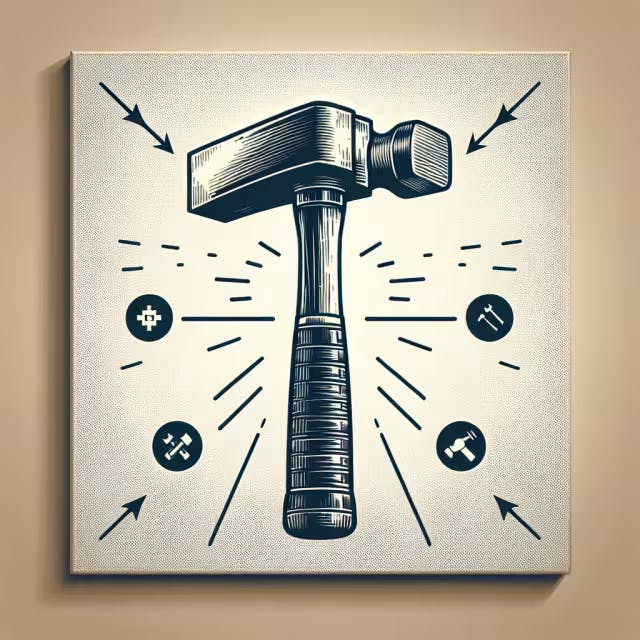
Top Features to Look for in a Forging Hammer
When selecting the best blacksmith hammers for forging, prioritize hammers with proper balance. A well-balanced hammer reduces strain on the arm, increasing precision and efficiency when molding metal.
Weight is another crucial factor – different weights are suited for various tasks. For instance, a heavier hammer might be used for forging larger items, while a lighter one could handle more delicate work. Handle material also plays a significant role in comfort and grip, with wooden handles absorbing shock and reducing fatigue.
Review the key characteristics to consider:
Balance: Ensures control and accuracy.
Weight: Match with the task at hand. Lighter hammers for detail, heavier for substantial forging.
Handle: Material choice affects grip, shock absorption, and overall comfort.
When selecting these tools, remember that each hammer is unique, much like the forged items a blacksmith crafts, and the choice often comes down to personal preference and the specific requirements of the projects at hand.
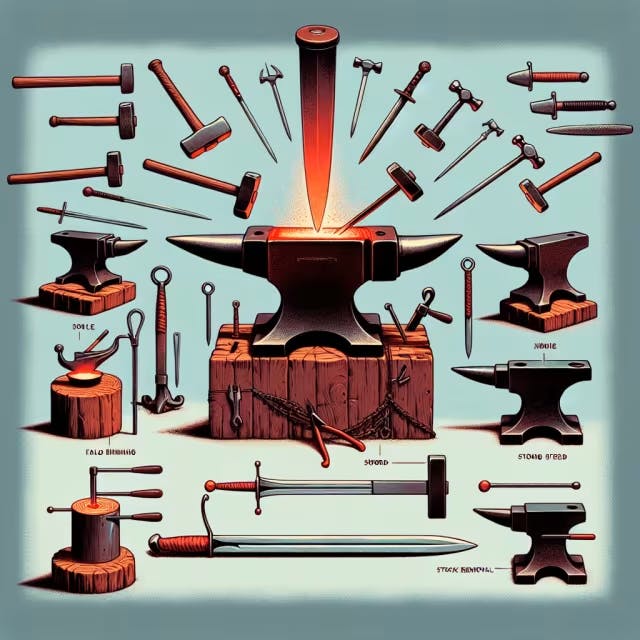
The Best Forging Hammer Materials for Durability and Balance
Selecting the right material for a blacksmith hammer is crucial to ensure long-lasting durability and optimal balance during the forging process. When looking at the craft of sword making, materials such as copper, bronze, and steel have been the backbone of this ancient practice. These materials are revered for their hardness, strength, flexibility, and naturally, their balance — essential qualities that also make for an outstanding blacksmith hammer.
Steel stands out as the preferred choice for many professionals when it comes to forging hammers. The properties of steel hammers offer resilience and the ability to withstand repeated blows on hot metal without deforming. Moreover, a well-forged steel hammer helps in reducing vibrations transmitted to the hand, making it more comfortable to use over long periods.
On the other hand, considerations from the gaming world, like those around the Tetra tools in the Enigmatica mod pack, highlight the importance of not just the material itself but also the quality and enchantability for enhanced utility. To address these points, the blacksmithing community must ensure that hammers crafted from superior materials are equally capable of receiving custom modifications and treatments. The call for high-quality materials such as enriched steel alloys may offer blacksmiths an edge in creating tools that are as enchantable and versatile as they are durable and well-balanced.
The following table provides a snapshot of the most favored materials used for blacksmith hammers, their characteristics, and suitability for forging:
Material | Hardness | Durability | Vibration Dampening | Suitability for Enchantments |
Steel | High | Excellent | Good | Moderate |
Copper | Low | Good | Poor | Low |
Bronze | Medium | Very Good | Moderate | Low |
Alloy | Variable | Excellent | Excellent | High |
Remember, the selection process for the best blacksmith hammers for forging should incorporate a desire for robust tools that can last a lifetime, maintain their shape through thousands of strikes, and deliver a comfort that only a balanced hammer can provide. By learning from both historical sword making techniques and modern feedback, blacksmiths can forge ahead with tools that meet the needs of today's craftsmen.
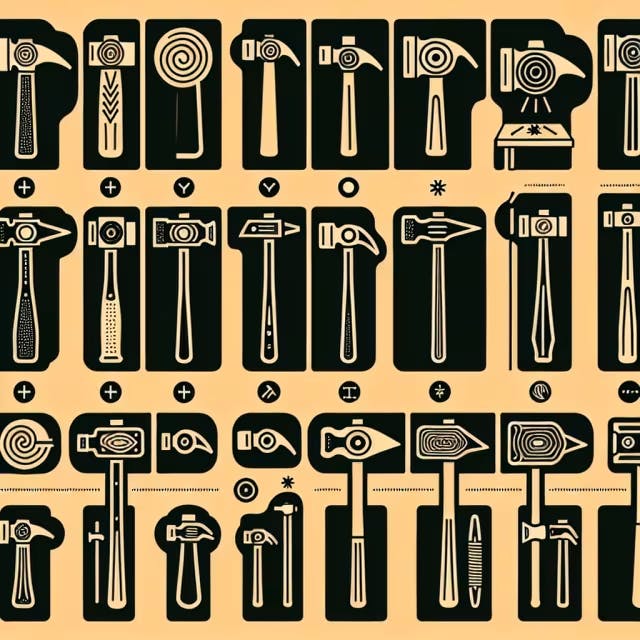
Hammer Handle Types and Their Impact on Blacksmithing Efficiency
The material of a hammer handle is not only a preference but also contributes to the tool's overall efficiency and safety when forging. Traditional wood handles absorb some of the shock from the impact and are easier on the blacksmith's hands. They are also easy to replace and come in various woods like hickory or ash, which are known for their durability and resistance to splintering.
Alternatively, modern hammer handles may feature synthetic polymers, offering superior durability and resistance to environmental factors. These materials can also be molded for an ergonomic grip, reducing the risk of slipping and providing additional comfort during prolonged use. Despite their benefits, synthetic handles may not absorb shock quite as well as their wooden counterparts and could result in more hand and arm fatigue over long forging sessions. The head must be securely attached to the handle to prevent accidents and ensure effective strikes.
Here is a quick reference table listing the types of hammer handles available:
Handle Material | Shock Absorption | Durability | Grip Comfort | Ease of Replacement |
Wood (Hickory) | High | Moderate | High | Easy |
Wood (Ash) | High | High | High | Easy |
Synthetic | Moderate | High | High | Difficult |
Choosing the right hammer handle can significantly impact your forging efficiency and comfort. Regardless of material, the best blacksmith hammers for forging will balance weight, handle comfort, and durability to meet specific forging needs. Always ensure the handle material suits your personal preferences and the demands of your blacksmithing projects. For more detailed information about the evolution and types of hammers, visit Wikipedia.
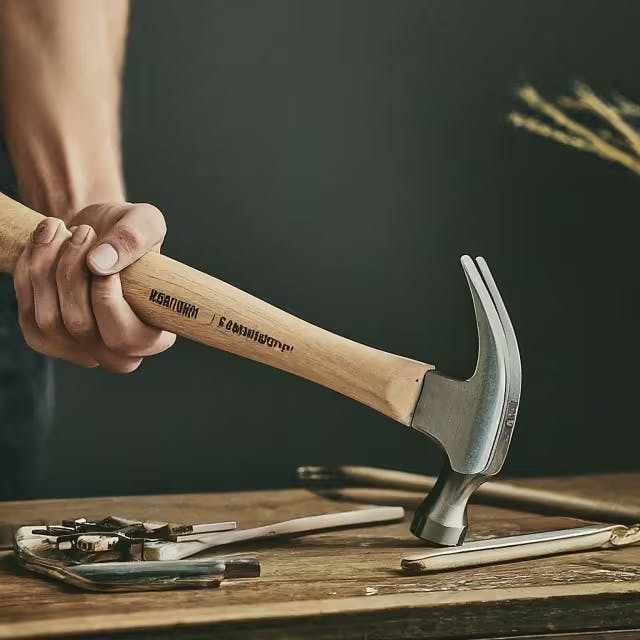
Essential Hammer Maintenance Tips to Prolong the Life of Your Tool
Keeping your blacksmith hammer in a prime condition not only ensures better-forging results but also extends your tool’s life. Regular maintenance minimizes wear and prevents potential accidents caused by hammer or handle failure. Here are some practical care tips:
Inspect Before Use: Make sure you inspect your hammer before each use for signs of wear or damage, particularly focusing on the head and handle connection.
Cleaning: Post-use, remove debris and buildup with a soft cloth to keep the head free from rust and the handle smooth.
Proper Storage: Avoid moisture and corrosive chemicals by storing your hammer in a dry environment, preferably hanging it so as not to blunt its face or damage its handle.
Handle Care: Should the handle become loose, re-fit it promptly to maintain performance and safety. Periodic light sanding will keep it smooth and free of splinters.
Periodic Oiling: A light coating of oil on the hammer head and handle protects against rust and drying out, respectively.
Avoid Misuse: Use your hammer for its intended purpose only—forging metals. Striking surfaces that are too hard or improper use can cause cracks or splinters.
Ensure your best blacksmith hammers for forging endure the rigors of your craft, with proper maintenance saving you time and money in the long run.
Maintenance Task | Frequency |
Inspect Before Use | Daily |
Clean After Use | After each session |
Store Properly | Always |
Handle Maintenance | As needed |
Apply Protective Oils | Monthly |
Use Appropriately | Always |
Remember that careful maintenance also impacts the precision of your craft, allowing you to effectively shape metals with confidence and safety. In conclusion, the key to effective forging is choosing a hammer that offers the best balance, weight, and handle material to suit your specific needs. Whether it's the precision of the Vaughan 591-10 SH or the endurance offered by the Estwing Sure Strike, there's a hammer out there tailored for every blacksmith. Regular maintenance on these durable steel tools will keep your investment in top condition, ensuring that your forging projects continue with efficiency and safety.
Frequently Asked Questions
What are the top features to look for in the best blacksmith hammers for forging
The best blacksmith hammers for forging should have a well-balanced design, a weight suited to your specific forging tasks, and a handle material that offers comfort and good shock absorption. Here are the top features to look for:
Balance: The hammer should feel natural in your hand, allowing for accuracy and control during the forging process.
Weight: Heavier hammers are typically used for larger projects, while lighter hammers are better for detail work.
Handle Material: Look for durable materials like hickory wood for shock absorption or synthetic polymers for ergonomic grip and environmental resistance.
Selecting a hammer with these qualities ensures a tool that can deliver precise blows, withstand the demands of the forge, and reduce fatigue for the blacksmith.
How does the Picard Hammer 0000811-1000 stand out in the blacksmithing community?
The Picard Hammer 0000811-1000 is celebrated in the blacksmithing community for its exceptional balance and quality, making it ideal for a variety of forging tasks. Engineered in Germany, this hammer caters to both professionals and hobbyists by providing superior control and a durable, 1000g head that is suited for all-purpose forging. The use of hickory for the handle is a classic choice that enhances the tool's durability and provides natural shock absorption to reduce fatigue during work.
Why is the Estwing Sure Strike hammer a wise choice for blacksmiths who forge for extended periods?
The Estwing Sure Strike hammer is an optimal choice for blacksmiths engaged in extended forging sessions due to its 40-ounce head and fiberglass handle. This combination offers several advantages:
Shock Absorption: The fiberglass handle absorbs shock, reducing the impact on the blacksmith's arm and hand, which is critical for minimizing fatigue during long forging periods.
Comfort: It provides a comfortable grip, which further helps to alleviate strain and allows for extended usage without compromising on control or power.
Durability: The Estwing Sure Strike is crafted for durability, ensuring that it can withstand the rigors of repetitive use in a blacksmithing environment.
When should you choose a hammer like the Vaughan 591-10 SH for your blacksmithing projects?
The Vaughan 591-10 SH should be chosen for your blacksmithing projects when you need a hammer that is suited for detailed work and smaller projects. With its 1.5-pound head and sturdy hickory handle, this hammer is ideal for tasks where precision is key. Here are a few scenarios when this hammer would be the right choice:
Detailed ornamental work where accuracy is more important than brute force.
Smaller projects that require finesse rather than the power of heavier hammers.
Situations where you'll need to minimize fatigue for prolonged periods of delicate forging.
Match this tool to the specific requirements of your blacksmithing endeavors for the best results.
What role does balance play in selecting a blacksmith hammer for forging
Balance is a critical factor in selecting a blacksmith hammer as it directly influences the control and comfort a blacksmith has during forging. A well-balanced hammer allows for more accurate strikes and reduces the chances of fatigue, which is especially important when working on detailed projects or for extended periods. Here are key points to consider:
Balance: Essential for ensuring control and precision when striking metal; helps maintain the blacksmith's rhythm and reduces arm strain.
Weight: Should be chosen based on the tasks; lighter hammers are typically used for finer work, while heavier hammers are better suited for shaping larger items.
Handle Material: Affects the hammer's balance, grip, and shock absorption; materials like hickory provide a good balance between comfort and durability.
The choice of the hammer should be informed by these factors to maximize efficiency and quality in metal crafting.
How important is handle material in the performance and comfort of blacksmith hammers?
The handle material of a blacksmith hammer significantly affects the performance and comfort during forging. Here's why it's important:
Shock Absorption: Wooden handles, like hickory or ash, absorb the shock from striking, reducing fatigue and minimizing the stress on a blacksmith's hands. This is essential for maintaining control and precision during extensive forging sessions.
Durability and Comfort: Wood is traditionally favored for its ease of replacement and natural resistance to splintering, while synthetic handles offer greater durability and can be shaped for an ergonomic grip, although they may not absorb shock as effectively.
Safety: A handle that is securely attached to the hammer head is critical for safety. It ensures effective strikes and prevents the head from becoming a dangerous projectile.
In summary, selecting a handle material that balances shock absorption, durability, and comfort, can greatly enhance a blacksmith's efficiency, effectiveness, and safety during forging.
What maintenance tips can prolong the life of your blacksmith hammer?
Regular maintenance of your blacksmith hammer is essential for optimal performance and longevity:
Inspect Before Use: Check the hammer for damage or wear before each session, particularly at the head-handle junction.
Clean After Use: Wipe the head and handle with a cloth to remove debris and prevent rust or deterioration.
Proper Storage: Store the hammer in a dry place and hang it to avoid blunting the face or damaging the handle.
Handle Care: If the handle is loose, secure it back into place. Sand it down occasionally to keep it smooth and prevent splinters.
Periodic Oiling: Apply oil to the head and handle to protect against corrosion and drying.
Avoid Misuse: Employ the hammer only for its intended blacksmithing tasks to avoid undue damage.
Through consistent care, your hammer will be better prepared to withstand the demands of forging, ensuring both the quality of your work and your safety.


